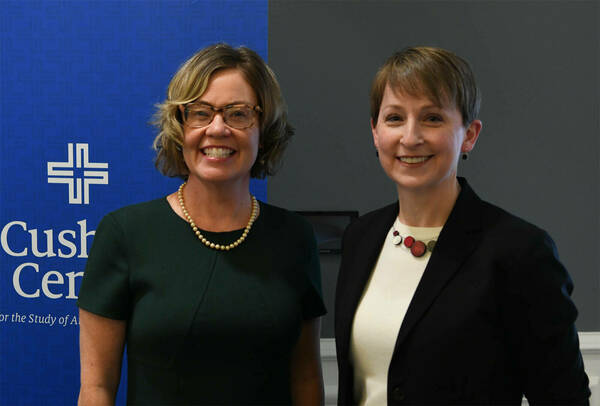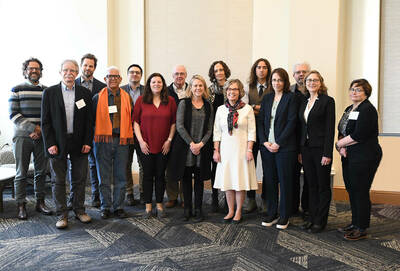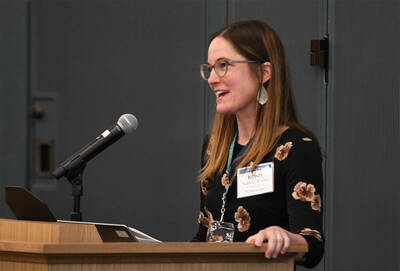
Cushwa Center Lecture: Rebecca Davis
Five years after winning a Research Travel Grant from the Cushwa Center and visiting Notre Dame to work in the University Archives, historian Rebecca Davis (University of Delaware) returned to campus to speak on some of the material she found. Her 2022 Cushwa Center Lecture, titled “The Woman: Clare Boothe Luce and the Politics of Religious Conversion,” expanded upon themes from her recent book Public Confessions: The Religious Conversions That Changed American Politics (UNC, 2021). Before a crowd gathered at the Morris Inn on the afternoon of February 8, Davis argued that Luce’s conversion to Catholicism in early 1946 provided the model for subsequent “religiously political converts” in Cold War America. The public nature of Luce’s conversion created a stir, prompting commentary in homilies and the Catholic press as well as in national radio broadcasts and outlets including the New York Times. More significantly, it advanced an argument for Catholicism’s unique ideological potential. Luce’s example suggested that fidelity to the Roman Catholic Church was not simply compatible with loyalty to the United States, it was the ideal faith for the flourishing of anti-communism.
Davis began by recapping Luce’s extraordinary path to conversion. Beginning with her 1923 marriage to the millionaire George Brokaw and continuing through her emergence as a celebrated periodical writer and playwright in the 1930s, her public image conveyed all confidence and glamor. Her 1942 election as one of only seven women in Congress cemented that standing, with the New Republic identifying her as part of the “vanguard” of a new type of Republican. Prominence afforded numerous opportunities, including a major address at the 1944 Republican National Convention, but it also inspired frenzied—and often demeaning—attention in the national press.
Yet all that success masked significant misery, and by the mid-1940s Luce had begun a search for religious meaning. Life in Washington introduced her to a person with answers, the Catholic University of America professor and priest Msgr. Fulton J. Sheen. Dialogue with Sheen and copious reading of the material he recommended soon persuaded Luce that Catholicism offered “the most reasonable” solution not only to her questions about suffering but also to the threat of Soviet communism, which Luce believed to be the “religion of the Antichrist.” Her advocacy proved just as effective in faith as it had in politics. From February to April of 1947, she published a three-part series in McCall’s, titled “The Real Reason.” In it, she made a painstaking defense of her conversion. Interested readers reached out in droves, and she spent much of the years ahead in correspondence, speaking engagements, and continued writing, including articles such as “The Catholic Mind and the Protestant Heart.” Davis demonstrated how these accounts were selective, for example making no mention of Clare’s troubled marriage to the publishing magnate Henry Luce. In conversion as in politics and culture, Luce constructed a public image that belied certain private realities.
Davis took special pains to explain how gender informed Luce’s conversion. In the Virgin Mary, Luce discovered a model of “redemptive suffering” that could speak to challenges facing modern women. From her mother’s apparent suicide and her daughter Ann Clare Brokaw’s death at the age of 19 to her two unhappy marriages and the suicides of several close friends, Luce’s life had been marked by suffering. One letter to Henry described their relationship as “at best, a fruitful friendship . . . at worst, an excellent discipline in the humiliation of my ego.” So while Luce rejected the contemporary notion of feminine submission, she embraced the model of subordination and virtue in suffering that she found in Mary’s “sanctified femininity.” In response to a question from Kathleen Sprows Cummings, Davis noted that this high view of Catholic womanhood did not seem to apply to the actual Catholic women Luce encountered. Her closest Catholic friends and confidantes were priests, not nuns, and Davis surmised that this reflected Luce’s general attitude toward other women, whom she typically found boring. She was attracted to power, and in Cold War America power generally resided with men.
For Luce, conversion boiled down to obedience—when interlocutors asked why she had abandoned her Protestant upbringing, her response was simply “because Catholicism is true.” But along with narrating the personal significance of this conversion, Davis reminded lecture attendees of its public ramifications. Clare Boothe Luce “helped create the public language of religious conversion,” a vernacular that persists even in the 2020s.

Research symposium: Gender, Sex, and Power
In recent decades, the prevalence and handling of sexual abuse in the Catholic Church have emerged as significant topics of discussion among scholars of religion as well as among Catholics themselves. Until recently, little scholarly research had focused on the history of this topic. In late 2019, Cushwa Center director Kathleen Sprows Cummings received a grant through the University of Notre Dame’s Church Sexual Abuse Crisis Research Grant Program for the project “Gender, Sex, and Power: Towards a History of Clergy Sex Abuse in the U.S. Catholic Church” (GSP). The project, which facilitated the work of 11 outside scholars and included a partnership with BishopAccountability.org for access to source materials, concluded with a research symposium on March 27–29, 2022.
Opening remarks were given Sunday evening by Kathleen Sprows Cummings, who welcomed the participants and thanked them for their research on such a difficult topic. With Robert Orsi (Northwestern University) serving as chair, the symposium’s first panel began with R. Marie Griffith (Washington University in St. Louis) presenting on the topic of female sexual abuse survivors of all ages, emphasizing the lack of data available on female survivors and the gap between what is known about men and women survivors. Terence McKiernan (BishopAccountability.org) presented on the role of the sacrament of confession and the space of the confessional as an integral aspect of understanding clergy sex abuse. To conclude the evening, Cummings spoke on the life and work of Catherine Mulkerrin, C.S.J., who in 1989 was asked to work as assistant director of the Boston Archdiocesan Office for Victims of Abuse. Cummings emphasized the importance of Mulkerrin performing her duties with the utmost sensitivity and noted that many survivors preferred disclosing to a sister due to their distrust of clergy or other men.
Monday morning began with a panel featuring the GSP program director, Peter Cajka (Notre Dame). Focusing on a priest perpetrator in the Archdiocese of Louisville, Cajka explored the significance of this priest’s “internal life” and the reconstruction of his image as a diligent worker. Doris Reisinger (Goethe University), in her paper on reproductive coercion, called attention to scholars overlooking race, class, and gender in the sex abuse crisis. Pointing out that most clergy sexual abuse involves adult victims, not children, she called for further work concerning pregnancy as a result of clergy sexual abuse. Jennifer Beste (College of Saint Benedict and Saint John’s University) analyzed a case from Minnesota in which the recovery of a priest perpetrator was emphasized over the welfare of his victims; by equating abuse with other types of sin, these Catholics depicted the priest perpetrator as a type of Christ figure who had suffered at the hands of the legal system.
The second panel of the day opened with Jack Downey (University of Rochester), whose focus on the priest Jim Poole demonstrated the significance of priests embodying “the new Catholic cool” as a way to attract potential victims. Downey also connected with McKiernan’s points on confession, noting that Poole was known for “terrorizing” girls in the confessional. Next, Kathleen Holscher (University of New Mexico) analyzed the “new Catholic missions” of the post-boarding school era, highlighting the issue of access to personnel files. Her research argues persuasively that sexual abuse of Native individuals was “particularly immune from scandal,” necessitating a closer look at additional sites of abuse. Concluding the panel was John Seitz (Fordham University), who analyzed the ways in which clericalism contributed to and shaped clergy abuse dynamics. His emphasis on power and the social production of the priesthood suggests that a re-orienting of the Church hierarchy may minimize this historical tendency towards clericalism.
The final panel of the symposium began Monday afternoon with Kara French (Salisbury University). Her research focused on the manipulation of the definition of celibacy used by many perpetrator priests to commit abuse. French argued that the vow of celibacy is more complicated than canon law implies and its position as “unstable” contributes to the perpetuation of sexual abuse. French also emphasized the culpability of seminaries and the education of priests as a vehicle through which the manipulation of celibacy can begin. Christiaan Jacobs-Vandegeer (Australian Catholic University) next analyzed Catholic theology’s role in the abuse crisis, arguing that “theology is mobile” and therefore cannot fix the crisis alone. He identified scholars’ role as “mapping” the crisis and pointed to the multitude of obstacles in doing so when attempting to acknowledge the trauma of abuse victims.
Next, Colleen McDannell (University of Utah) presented her scholarly model of the abuse crisis that shifts from the question of systemic factors to the role of the nuclear family. A key aspect of understanding the involvement of families, McDannell argued, is how many parents considered it an honor to invite their local priest into the home for a meal. This idea of a “good Catholic home” involved regarding priests as a “sanctifying presence” in the home while assigning children to the bottom tier of the domestic hierarchy. This hierarchy, then, contributed to a lack of belief in victims if they tried to come forward with the abuse they experienced. Finally, James O’Toole (Boston College) completed the symposium with another link back to the concept of clericalism through a case study of sex abuse in the Archdiocese of Boston. To explore what clericalism might have been to both survivors and perpetrators, he focused on the role of seminaries—not just their academics, but the ways in which they shaped priests’ thoughts and action through the process of priestly formation. O’Toole pointed out that since Saint John’s Seminary in Boston formed many abusers, particularly pre-Vatican II, scholars should aim to uncover patterns in the formation process that might foster abusive priests.

Seminar in American Religion: Kristy Nabhan-Warren
On Saturday, April 2, 2022, the Cushwa Center hosted its Seminar in American Religion to discuss Meatpacking America: How Migration, Work, and Faith Unite and Divide the Heartland (UNC Press, 2021) by Kristy Nabhan-Warren, professor and V.O. and Elizabeth Kahl Figge Chair in Catholic Studies at the University of Iowa.
Kathleen Sprows Cummings welcomed participants and introduced the seminar’s two commentators, Elizabeth Pérez (University of California, Santa Barbara) and Daniel Graff (Notre Dame). Pérez began by commending Nabhan-Warren’s ethnographic method and writing style, and called Meatpacking America a powerful work of advocacy on behalf of migrants and working people. While not an exposé treatment of the protein industry or a railing against meat culture, Meatpacking America serves as a window into agribusiness which, even at its most ethical, degrades the environment, treats workers as expendable, and benefits from the chain migration it helps set in motion.
Pérez assessed that Nabhan-Warren elucidates the divergence between the interests of workers and owners not through an explication of Marxist theory but through a close-grained exploration of workers’ lives. This is especially evident in her unflinching attention to the act of killing. Highlighting parallels she saw between meatpacking labor and religious butchering in Santería, Pérez suggested that Nabhan-Warren has broken a path for scholars to explore themes of ritual sacrifice without sensationalizing violence.
By way of critique, Pérez said she was uncomfortable with the subjects’ frequent descriptions of Iowa as a “safe place,” which she felt is coded language for a place without Black people. Pérez lamented that this reveals how Latino immigrants are encouraged to see Black people as “other” and therefore do not seek solidarity with them.
Graff commended Nabhan-Warren for rejecting caricatures of heartland residents and insisting on the humanity of her diverse subjects. Stories of aging white Catholics negotiating parish spaces with newcomers made Graff long for even more exploration of the ways whiteness works to claim space. Stories revealing refugees’ overlapping fear, gratitude, and hope made Graff wonder if they weren’t still holding back some stories of suffering because they couldn’t resolve their paradoxical emotions.
Graff argued, however, that there is a silence around worker resilience and resistance in Meatpacking America. Nabhan-Warren focuses on employers’ evangelical values and on workers’ resistance to their attempts to sacralize the workplace, but Graff wondered about other forms of worker resistance over pay, the pace of work, and other labor issues. While the plants that Nabhan-Warren details have not been unionized, other plants in Iowa have been. Graff asked what these unions have to say about these particular plants and what the Church has to say about labor in this particular setting. He suggested that Nabhan-Warren’s analysis would benefit from being contextualized within the history of the multi-ethnic labor movement that brought some justice and reform to the meatpacking industry between the era of The Jungle and today. The laborers in Meatpacking America, Graff insisted, are part not only of the revitalization of heartland towns but also of American labor.
Thanking both commentators, Nabhan-Warren noted that her research was done before the outbreak of COVID-19 and that in its wake unionization efforts have been revived through a focus on workplace safety. She agreed that a revised version of the book, with an epilogue on the post-COVID period, would include greater focus on worker resistance.
During a period of question-and-answer, Thomas Kselman (Notre Dame) noted that the chaplains hired by the meatpacking plants came from a military background and wondered if exploring these two realms more closely would reveal new insights into the social function of religion. In both settings, chaplaincy is meant to provide resilience and social control in order to facilitate killing. Nabhan-Warren added that one of the chaplains she interviewed has since moved on to hospital chaplaincy because he began to feel complicit in the dehumanizing conditions of the plant. Both Jacqueline Willy Romero (Notre Dame) and Valerie Sayers (Notre Dame) asked questions about what might make white residents more welcoming of immigrants and the role the Church can play in that transformation. Nabhan-Warren answered that as much as activists talk about grassroots organizing, it is also clear that making change from within institutions such as the Church requires clergy leadership. She highlighted the progress achieved by priests who challenge and encourage white parishioners to learn Spanish or to attend Our Lady of Guadalupe celebrations as a way of bringing white and Latino parishioners together.
Cummings asked about the parallels between parish closures in rural communities and in the ethnic Northeast and how clerical sexual abuse, settlements, and diocesan bankruptcies are connected to the story of parish consolidation and closure. Nabhan-Warren admitted that she did not ask her subjects about sexual abuse but noted that while no white Catholics talked about the issue, some immigrants she interviewed experienced sexual abuse not in the parish but on the refugee path. John McGreevy (Notre Dame) suggested that Meatpacking America provides a vision for an emerging multi-racial, multi-ethnic, labor and community solidarity that leans politically leftward, but he argued that, given the voting trends of Latinos and union households, a socially conservative multi-ethnic coalition is equally likely. Graff agreed and proposed that the formation of a nationwide working class unified across racial lines was actually the less likely possibility. Pérez lamented that the Democratic National Committee (DNC) still holds a monolithic view of Latinos as class-based DNC voters and warned that this link has to be constantly built, not just assumed. At the same time, Pérez warned that the DNC ignores anti-Blackness among Latinos at its own peril.
Philip Byers, Stephen M. Koeth, C.S.C., and Jacqueline Willy Romero were postdoctoral fellows at the University of Notre Dame’s Cushwa Center during the 2021–2022 academic year.
Feature image: Kathleen Sprows Cummings and Rebecca Davis at the Cushwa Center Lecture, February 8, 2022.